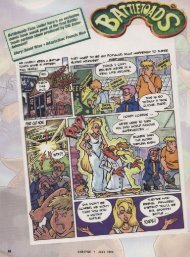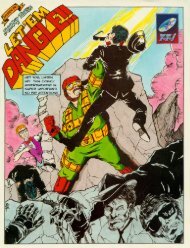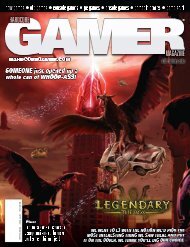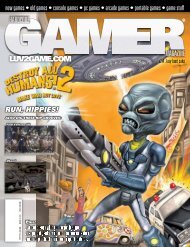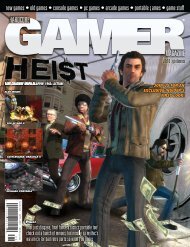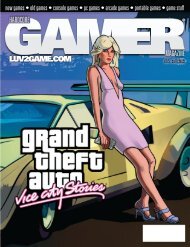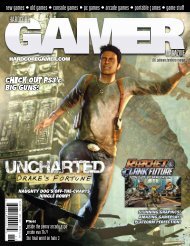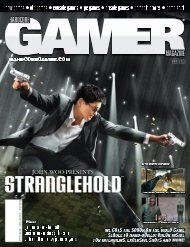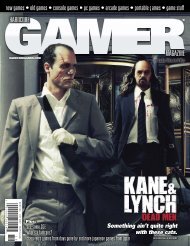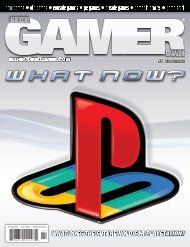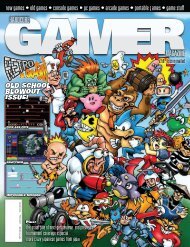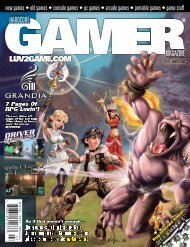worth importing? - Defunct Games
worth importing? - Defunct Games
worth importing? - Defunct Games
You also want an ePaper? Increase the reach of your titles
YUMPU automatically turns print PDFs into web optimized ePapers that Google loves.
Curt Vendel<br />
(Atari Flashback Lead Engineer)<br />
Interview by Melf<br />
Curt Vendel, the lead engineer and project manager for the<br />
Flashback line of consoles, sheds some light on the project and<br />
how it’s developed.<br />
HGM: The first Flashback console sold well enough (over<br />
500,000 units), but there was a general feeling among fans that<br />
something was missing. How soon after it shipped did the decision<br />
to revise it come about?<br />
CV: Atari requested engineering meetings in early Dec ’04 to<br />
receive product specifications for the next console designs.<br />
HGM: Were there any ideas that didn’t make it into the final<br />
2.0 design?<br />
CV: USB to Host connectivity and Media slot for multi-game<br />
paks.<br />
HGM: The new unit looks pretty slick, even sporting a 2600style<br />
box. Were you trying to appeal to the entire spectrum of<br />
Atari fans, beyond just those who originally enjoyed the 2600<br />
during its heyday?<br />
CV: The Flashback 2 is a replica 2600 system with updated<br />
buttons replacing the old ’70s stereo toggle switches. The idea<br />
was to create a modern rendition of a videogaming icon console<br />
and joysticks.<br />
HGM: The RCA output is very nice, considering that the 2600<br />
was originally played in snowy RF. Was it ever a consideration to<br />
include more advanced connections, like S-video, for example?<br />
CV: The development hardware could actually produce VGA,<br />
[but] this was not incorporated into the final silicon. Only composite<br />
output [was].<br />
HGM: Probably the biggest difference between the 2.0 and the<br />
original Flashback is that the new unit uses an actual 2600 chip,<br />
as opposed to simply emulating the hardware. Were there ever<br />
any plans for the first unit to use the chip, or was the decision<br />
made for the revision only?<br />
CV: Originally in May of 2004, Atari contacted my engineering<br />
firm to produce their first console. After two weeks, we submitted<br />
a timeline of four months to development and six months to<br />
production. Unfortunately, that timeline would not put them into<br />
the holiday ’04 sales season, so it was either [we] get something<br />
out the door with this opportunity, or Atari may not be<br />
willing to reconsider this kind of hardware project again in the<br />
future. Atari up until that point had been strictly a software and<br />
licensing company; this would be their first in-house hardware<br />
product, so it was a big gamble. So we produced on an off-theshelf<br />
chip platform and re-wrote twenty games and [the] menu<br />
in ten weeks.<br />
HGM: The first Flashback unit had a mixture of 2600 and 7800<br />
games. Why the decision to go 2600-only this time? Any chance<br />
of a 5200 unit?<br />
CV: Since Flashback 2 is a modern rendition of the 2600, a<br />
2600-specific chip was developed. As for the future, we already<br />
have a new chip about 85% laid out, and if Flashback 2 does as<br />
well as expected, the next jump from version 2 to version 3 (if<br />
it is called that) will be even bigger then the jump from version<br />
1 to version 2.<br />
HGM: Compatibility with authentic 2600 peripherals goes a long<br />
way towards making the experience as authentic as possible,<br />
and the Flashback 2.0 unit comes with two new authentic joysticks.<br />
How improved are they over the original 2600 sticks?<br />
CV: Utilizing gold contact points and conductive rubber pads<br />
greatly improves the reliability. The sticks themselves have been<br />
completely redesigned with solid plastic shafts that screw into<br />
a new 8-way base plate with rubber center ring. The old hollow<br />
shaft covered in rubber design had major problems. The new<br />
CX-40B’s have improved on much of the original CX-40’s design<br />
in durability and reliability while keeping the feel of the joysticks<br />
very close to the originals.<br />
HGM: I love the fact that there are seven unreleased games<br />
included, and seven which are entirely new. I’m sure fans are<br />
wondering where they came from. Is this all there is, or are<br />
there more 2600 games waiting for their chance to shine someday?<br />
CV: To appeal to a broad spectrum of gamers, including<br />
hardcore 2600 fans, the decision was made to look at the 2600<br />
library and see what games had never been ported to the 2600,<br />
look at some of the more famous games in the 2600 library,<br />
and create sequels. There are a couple of hidden games in the<br />
console as well. Ideas are already on the drawing board for the<br />
next chipset to bring even more games to that platform that<br />
had never been done as well, so there is a lot of creative thinking<br />
and coding going on at Atari.<br />
HGM: Atari seems to really want to establish a relationship with<br />
the homebrew community, hence the four homebrew games<br />
included. How were the games chosen?<br />
CV: After reviewing many of the homebrews, a list and description<br />
of games were presented to Atari management in<br />
two meetings. Several games were chosen and the homebrew<br />
authors [were] contacted to see about making Atari-specific<br />
versions of their games for Atari and its Flashback 2 console.<br />
HGM: Are there any plans for a version 3.0?<br />
CV: [It’s] already on the drawing boards and will go into more<br />
formal discussions after FB2’s launch.<br />
HGM: Two games, River Raid and Pitfall, were licensed from<br />
Activision. Could this mean future projects may see more third<br />
party games included?<br />
CV: Possibilities are always open. Hopefully other companies<br />
that had some shining star translations done on Atari hardware<br />
will want to consider having their games licensed on future<br />
products through Atari.<br />
Aaron Curtis<br />
(Fall Down Programmer)<br />
Interview by Melf<br />
HGM: How did the decision to port Fall Down to the 2600 come<br />
about?<br />
AC: I just sort of stumbled across the Atari homebrew scene<br />
back in 2004 one day while I was looking for a replacement joystick.<br />
There was really a wealth of information easily available,<br />
with tutorials, detailed hardware guides, and the like (the community<br />
deserves a lot of credit for all this). So anyway, having<br />
a good bit of experience with assembly programming already, I<br />
was like “Hey, I should do this.”<br />
As for Fall Down, I’ve always thought of it as a good project to<br />
HARDCORE GAMER MAGAZINE_VOLUME 1_ISSUE 4_A pr0nLESS PUBLICATION<br />
try when first learning a system (I’ve done several<br />
versions). Also, out of the ideas I had, it was the<br />
one that fit best within the Atari’s limitations; it<br />
didn’t need much memory, it only uses two sprites,<br />
it scrolls vertically (one of the few things that works<br />
well on the system), etc.<br />
HGM: How long did the project take you?<br />
AC: I guess most of the coding was done over the<br />
course of about two months last year. After that it<br />
took a few more months to get the manual and label<br />
art ready (Dave Exton did these, and I have to say<br />
he did a great job). During that time I added a few<br />
extra features, like the AtariVox support.<br />
HGM: The 2600 doesn’t offer much memory to work<br />
with. How did you get around the limitations?<br />
AC: As I mentioned earlier, it was more a matter of<br />
picking a game that I knew wasn’t going to need a<br />
lot of memory. Even so, I did find myself running<br />
out fairly early on, I guess since I wasn’t used to<br />
working with that little memory.<br />
Generally you have to overlap data, i.e. have an area<br />
of memory that corresponds to several things, depending<br />
on what the game is doing. That, and you<br />
have to watch your stack usage, since it’s included in<br />
the 128 bytes.<br />
HGM: Was there anything you wanted to include<br />
but had to leave out?<br />
AC: There are some obvious things that didn’t make<br />
it for technical reasons, like multiple high scores,<br />
in-game speech via the AtariVox, or just better<br />
graphics in general.<br />
Also, at various times, I wanted to add some different<br />
power-ups or game modes that didn’t work out,<br />
but those were largely due to incompatibilities with<br />
the existing code. For example, one guy suggested<br />
a “Joust” mode where the screen scrolled the other<br />
way.<br />
Generally though, I had enough time to fool around<br />
with the game that everything I could think of either<br />
went in or at least was attempted.<br />
HGM: How has Fall Down been received by the<br />
retro community?<br />
AC: Fairly well, I’d say. I entered an early version in<br />
the 2004 Mini-Game compo (minigamecomp.org.uk),<br />
where it was received pretty well. Also, the game<br />
has gotten a lot of praise on the AtariAge forums,<br />
where I’d been posting updates during development.<br />
Cartridges have been available from AtariAge for a<br />
couple weeks now, and from what I hear they’re<br />
selling pretty well... obviously not enough to make<br />
me rich (wait, wasn’t that the whole point? heh), but<br />
better than I expected.<br />
HGM: Are you working on any other homebrew<br />
projects, on other consoles maybe?<br />
AC: I’ll probably enter something in this year’s Mini-<br />
Game compo, so yes. As for other consoles though,<br />
I only really tend to write for systems that I actually<br />
have, so that’s somewhat limiting. I’m honestly not<br />
much of a collector.<br />
HARDCORE GAMER MAGAZINE_VOLUME 1_ISSUE 4_A pr0nLESS PUBLICATION<br />
(continued from page 37)<br />
Homebrew<br />
Homebrew<br />
Spotlight<br />
Spotlight<br />
FALL DOWN (By Aaron Curtis)<br />
This is by far my favorite out of this list, and Fall Down is solid proof that you<br />
don’t need millions of polygons to make an impressive game. Based on a classic<br />
TI-86 calculator game, the action revolves around<br />
the struggle between RED and BLUE to capture<br />
vertically-scrolling platforms. Beat your opponent to<br />
the nearest opening, and turn the platform to your<br />
color, gaining you a point. The more you progress, the<br />
faster the platforms scroll. There are power-ups and<br />
even speech, using Richard Hutchinson’s AtariVox.<br />
Even cooler is that the AtariVox will save your high scores!<br />
Very impressive for a homebrew title and highly addictive, Fall Down features<br />
multiple levels of challenge, including options to make a player invisible via<br />
color-alternating backgrounds. There’s nothing but fun here, folks, and while<br />
it’s leagues better with a friend, the computer AI is no push-over.<br />
GO FISH! (By Bob Montgomery)<br />
Intellivision fans will immediately see the resemblance<br />
to Shark! Shark! here, but please, stay for a while and<br />
see why Go Fish! is just so darn cool. One of the few<br />
2600 games to sport continuous music (even at the<br />
title screen), it has you taking on the role of a wee<br />
little fish that must eat to survive. The more you eat,<br />
the bigger you get. The bigger you get, the more the shark will see you as a<br />
meal in your own right. I found it to be quite fun, swimming around, looking<br />
for lunch. It seems to be the most repetitive out of this bunch, but it’s amazing<br />
what Montgomery squeezed into this tiny cart. It’s an impressive feat.<br />
Go Fish! also uses the AtariVox to save your high scores. There’s no Jaws<br />
theme, though.<br />
GUN FIGHTER (XYPE)<br />
First things first: this is not Outlaw. One look and it becomes painfully clear<br />
that this blows the pants off of Atari’s 1978 western shooter in many ways,<br />
and even makes that game obsolete. You know<br />
you’re in for something special when the intro plays<br />
an 8k rendition of Johnny Cash’s Ring of Fire! This is<br />
your standard one-on-one duel of old, and you can<br />
maneuver in eight different directions as you attempt<br />
to gun down your opponent. Shots ricochet off walls,<br />
and cacti and stampedes offer cover, but it’s the challenge<br />
of gunning down your foe before you run out of ammo that makes this<br />
game so much fun. You can even get your hat shot off! All this makes for some<br />
decent strategy, and Gun Fighter’s frantic pace is tons of fun.<br />
STAR FIRE (XYPE)<br />
George Lucas should either be flattered or calling his lawyer. Star Fire borrows<br />
so heavily from his famous saga that you may initially be left wondering how<br />
to react; however, once you begin playing, you really<br />
won’t care. This game is fun, pure and simple, and<br />
that’s what counts. Based on the 1979 arcade game,<br />
Star Fire injects a ton of new features for the home<br />
release. The programmers even added some cool<br />
effects, like your HUD scrambling when you take a hit,<br />
and overall, Star Fire actually looks pretty darn good<br />
for a 2600 game. It’s colorful, well-detailed, and plays very fluidly.<br />
Most of these games were released in limited quantities during the Classic<br />
Gaming Expo or another, similar event, which means that your best bet at<br />
attaining a copy would be to scour eBay or your local message board. Playing<br />
new, fully-packaged 2600 games on the actual console is a rare treat, and the<br />
extra effort needed to find them is a <strong>worth</strong>y investment.



